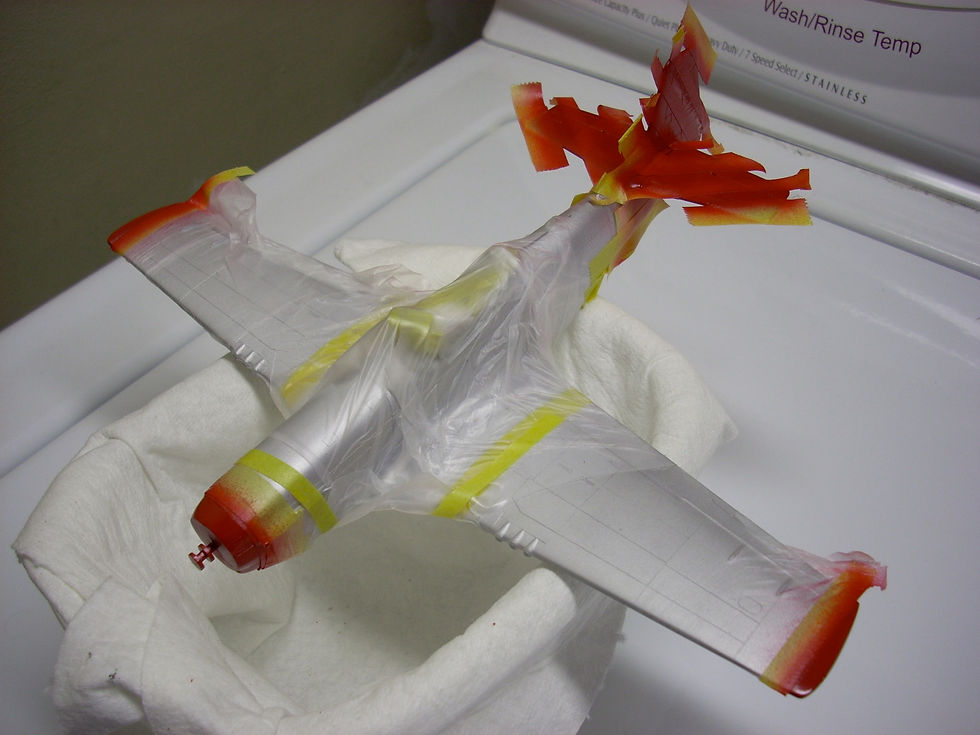The Masked Modeler Blog
- surber3
- May 2
- 3 min read
Updated: May 18

Beginners Corner
Masking


Beginners in model building may be puzzled by the term “masking” but learning this simple technique can take an excellently assembled kit to a new and dynamic level. Masking essentially means to cover up or hide from view. In the art of painting model kits, masking refers to covering parts of the model with a material to prevent paint from getting on specific areas of the surface, for example, when painting frames on aircraft canopies or windows. In this example, the model builder wants to apply paint so that it adheres to the frames or the areas around the windows but not to the windows themselves. To accomplish this, use a masking material such as tape. In the days of my youth, I used Scotch clear tape ̶̶ the one in the green package ̶̶ which is still a viable masking option. More modern tapes include Tamiya or Kabuki style yellow tape, painters tape, or any low-tack tape designed for masking. The reason to use low-tack or tape with a low adhesion (also known as “stickiness”) is to be able to remove the tape from the model (and any underlying paint) without damaging the surface.
Other masking materials include: masking fluid (a latex-based liquid which is painted onto the surface to be masked), Bare Metal Foil (a product designed for use of car models to reproduce chrome trim), or precut masks designed for the specific model you are building.



When large surface areas need covering, any impervious material will suffice. In my work on aircraft I have been known to use printer paper, aluminum foil or discount store plastic bags. I usually mask finely around the borders to be painted with tape and then tape foil or paper to the tape on the model to ensure a perfect seal. I can’t emphasize this point enough; any portion of the model uncovered and not protected by a mask is subject to contamination with the undesired paint color. Nothing is more frustrating than to finish an airbrushing session and removing masks to find an area that wasn’t completely sealed, either due to accident or poor planning.


Tail of American Beauty P-51 masked with strips of Tamiya tape and the fuselage protected by plastic bag material.


Tape removed. Note the tail number decal has been applied before masking and painting to accurately reproduce this particular aircraft’s markings.
Sometimes using a mask is exactly like using a stencil, where the stencil is applied to the surface and a letter or symbol is applied in a contrasting color to the base color. This is true for national markings or complex camouflage on scale aircraft.


An example of a stencil used in sign making. Stencil of US national markings.
A new innovation in the technique of masking is the development of wheel bay plugs made of a foam plastic material. These wonderful products, developed by OMask, fit into the wheel bay of aircraft to protect detailed and weathered interior during the application of the underside color. These are reusable, unlike most precut masks and tape.


Tips and tricks when masking
If using tape with high adhesion (stickiness), the sticky side of the tape can be applied to the palm of the hand several times to make the tape easier to remove and reduces the risk of pulling up previous paint.
Use a toothpick, fingernail or other tool to press down the edge of the tape immediately before painting. The seal is very important, and when the paint is highly thinned, it may have a tendency to creep under the edge of the tape, especially on irregular or bumpy surfaces.
Some companies that provide masking material:
Precut Masks
Eduard – www.eduard.com
Art Scale - ASK Painting Masks | Vše pro modeláře Art Scale
Masking fluid, tape, stencils and wheel bay plugs
AK Interactive, MIG, Microscale, Abteilung, Tamiya, OMask: all available from Sprue Brothers Sprue Brothers Models LLC Home Page or Squadron Squadron.com - Adding To The Stash Since 1968
Learn more about masking by simply doing a search for videos about scale model masking on You Tube.



Comments